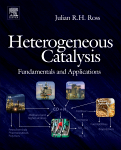Welcome
Welcome to the website for Ross, J: Heterogeneous Catalysis: Fundamentals and Applications.
Introduction: Catalysis is Fun
Gaining an understanding catalysis should be fun and the subject should be seen as a living topic, full of research opportunities rather than a dull topic involving just bookwork. I hope that by using this book and following through a number (if not all) of the internet-based tasks, the reader will gain a clear understanding of the subject and will also become as intrigued by the subject as I am. Perhaps catalysis will become for you, as for me, a way of life!
Catalysis is an important and very practical branch of chemistry with links to chemical engineering, physics and even biology and applications in many areas of technology. I believe that a full understanding of the subject also leads to a better knowledge of other topics: kinetics, thermodynamics, materials science, surface science, chemical technology, even economics. I have also always believed that catalysis should be taught as a core topic in chemistry and chemical engineering.
As I progressed with the writing of this book, I realized more and more that the best way to make sure that the content did not age was to make full use of Citation Indexing - Scopus or Web of Science or Google Scholar – and giving the reader a series of possible starting points for the literature in each topic of importance. The book is unashamedly based on my own experience and makes particular use of key articles to be found in Elsevier publications, particularly Catalysis Today, a journal which I edited for around 25 years.
The book can be approached on three different levels: as a straight text used as background reading associated with a course of lectures on the subject; as a self-study guide; and as a lead-in to a more advanced examination of a range of the topics covered, making particular use of internet resources.
With the addition of the supplementary material that you will find on this web page, it is my hope that this text will become a “Living Book”. Initially, I have assembled material which I hope will be of immediate use to the reader or to the instructor/lecturer following the book: electronic links to the web addresses given in the text and copies of the diagrams and tables in a form that can be adapted for use in lectures. (Note that some of the PowerPoint presentations included also have short audio descriptions/comments built into them to aid the understanding.) I will also, with time, add to the web pages additional tasks and exercises. I invite readers who might wish to contribute appropriate examples (or comments or errata) to pass them on to me at the address given below. And I also invite students to submit examples of their work on some of the tasks to this address so that the best of these can also be added to the web pages. Finally, in this connection, it should be noted that it will become possible for an instructor/lecturer to set up his/her own home page that might contain, for example, sets of examples or tasks that he or she might wish to use in their own specific courses.



